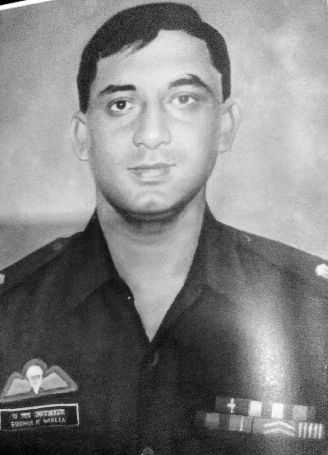Sudhir Walia — a braveheart who went beyond the call of duty
Col Dilbag Dabas (Retd)
Himachali soil has nurtured men of steel. Not just three Param Virs, the state has given to the Indian Army three bravest of the braves, who earned for themselves the coveted Ashok Chakra, the highest peace-time gallantry award.
Major Sudhir Kumar Walia is one such gem, which will glitter in Himachali crown till eternity.
Major Sudhir Kumar Walia, son of Subedar Major Rulia Ram Walia, was born on May 24, 1971, at Panuri village in Kangra district of Himachal Pradesh. Sudhir grew up listening about the valour of Indian soldiers from his father and knew that he was destined to be one. Even his father encouraged him to join the Indian military, which for the Himachalis is not just another career option, but a way of life, an honourable way of serving the motherland.
An alumnus of Sainik School Sujanpur Tihra and the National Defense Academy, Khadakvasla (Pune), he was the first boy from his village to become an Army officer. After his military training at the prestigious Indian Military Academy, Dehradun, he was commissioned into the Jat Regiment. As a subaltern, Sudhir was a part of Indian Peace Keeping Force (IPKF), where he had an impressive record of fighting and neutralising Liberation Tigers of Tamil Eelam (LTTE) in Sri Lanka in the late ’80s. Sudhir also demonstrated his raw courage and Himachali grit during his two tenures in Jammu and Kashmir fighting exported as well as home-grown militants. His gallantry in neutralising and eliminating terrorists in the Kashmir valley did not go unnoticed and for his conspicuous acts of bravery in the face of the enemy, Sudhir was awarded the Sena Medal for gallantry twice.
The Parachute Regiment (Special Forces), always on the lookout for the daredevils, noticed all the attributes of a Para Commando in Sudhir Kumar Walia and took no time in getting him on its establishment. After three months of probation and five mandatory parachute jumps, Sudhir was permanently seconded to 9 Parachute Regiment (Special Forces). During his outstanding military career spanning just about a decade, what Major Sudhir Kumar Walia achieved is exceptional and rare.
Kupwara district in Jammu and Kashmir has been and still is a hot bed of militancy in the Kashmir valley. The 9 Parachute Battalion (Special Forces) was deployed in Kupwara in 1999 for anti-terrorist operations. On August 29, 1999, Major Sudhir Kumar Walia was tasked to lead a squad of five commandos on “Search and destroy” mission through the dense undergrowth of Haphruda forest. His squad chanced upon a well-camouflaged hideout with 20 terrorists hiding in it. With total disregard to personal safety, Major Walia surged ahead of his squad and with the lightening speed not only neutralised the sentries, but also single-handedly killed four militants. In the cross fire, he, too, was hit in the face, arm and chest.
In spite of grave injuries, which were to prove fatal later, the gallant officer kept directing his men with his radio set and ultimately ensured that all terrorists were eliminated. Due to his fatal injuries and excessive loss of blood, Major Sudhir Kumar Walia breathed his last holding on to his radio set. This gallant officer went way beyond the call of duty and in the highest traditions of the Indian Army sacrificed his life for the country. For his most conspicuous act of bravery and supreme sacrifice in the face of the enemy, Major Sudhir Kumar Walia was awarded the Ashok Chakra, the highest peace-time military decoration, posthumously.
Major Sudhir Kumar Walia, AC, may be dead, but he still lives in the hearts and minds of not only the Himachalis, but all countrymen.
Highest peacetime military decoration in India
Ashok Chakra is the highest peacetime military decoration in India and equivalent to the Param Vir Chakra during war time. It is awarded for the most conspicuous act of bravery or some act of daring or pre-eminent valour or self-sacrifice other than in the face of the enemy on land, at sea or in the air. Ashok Chakra was instituted by the President of India on January 4, 1952.
Single-handedly killed four militants
The 9 Parachute Battalion (Special Forces) was deployed in Kupwara in 1999 for anti-terrorist operations. On August 29, 1999, Major Sudhir Kumar Walia was tasked to lead a squad of five commandos on “Search and destroy” mission through the dense undergrowth of Haphruda forest. His squad chanced upon a well-camouflaged hideout with 20 terrorists hiding in it. With total disregard to personal safety, Major Walia surged ahead of his squad and with the lightening speed not only neutralised the sentries, but also single-handedly killed four militants. In the cross fire, he, too, was hit in the face, arm and chest. In spite of grave injuries, which were to prove fatal later, the gallant officer kept directing his men with his radio set and ultimately ensured that all terrorists were eliminated. Due to his fatal injuries and excessive loss of blood, Major Sudhir Kumar Walia breathed his last holding on to his radio set. This gallant officer went way beyond the call of duty and in the highest traditions of the Indian Army sacrificed his life for the country. For his most conspicuous act of bravery and supreme sacrifice in the face of the enemy, Major Sudhir Kumar Walia was awarded the Ashok Chakra, the highest peace-time military decoration, posthumously.
(The writer is a veteran Gunner, 6 Field Regiment)









